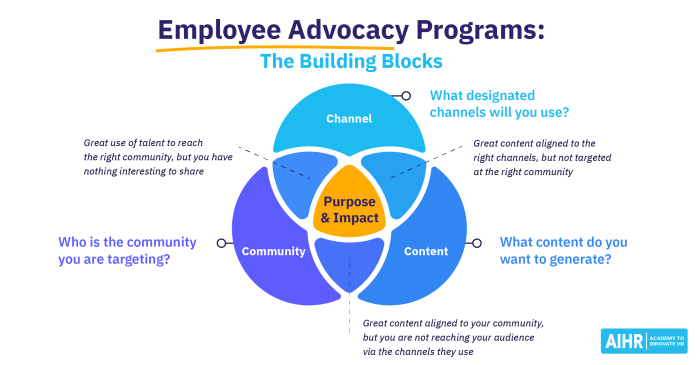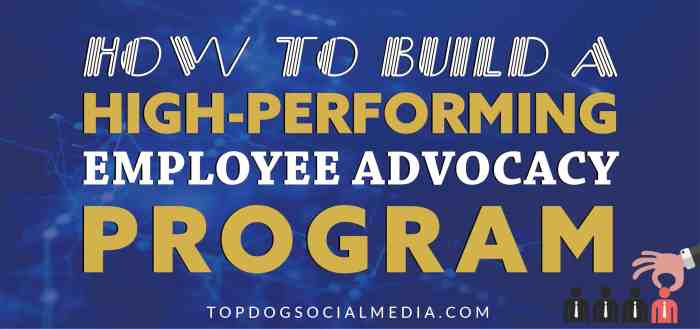Developing an Employee Advocacy Program dives into the world of empowering employees to be brand ambassadors, a crucial strategy for modern businesses looking to thrive in the digital age. Get ready to explore the ins and outs of this innovative approach!
Introduction to Employee Advocacy Programs
An employee advocacy program is a strategic initiative where companies encourage their employees to promote the brand and its products or services on social media and other platforms. This helps in leveraging the reach and credibility of employees to enhance the company’s reputation and visibility.
Significance of Employee Advocacy Programs
Employee advocacy programs are crucial in today’s business landscape as they tap into the power of authentic and trusted voices. Employees are seen as more trustworthy than corporate messaging, making their advocacy more impactful and engaging for the audience.
- Increased Reach: Employees have their own networks and followers, which can significantly expand the company’s reach and visibility.
- Builds Credibility: When employees share content about the company, it adds a level of authenticity and credibility that traditional marketing efforts may lack.
- Boosts Employee Engagement: Involving employees in advocacy programs can increase their sense of belonging and pride in the organization.
Benefits of Employee Advocacy Programs
Employee advocacy programs offer numerous benefits to companies, including:
- Enhanced Brand Visibility: With employees actively sharing content, the brand gets more exposure and visibility in the market.
- Improved Social Selling: Employees can act as brand ambassadors and help in generating leads and driving sales through their networks.
- Cost-Effective Marketing: Employee advocacy is a cost-effective way to promote the brand compared to traditional advertising methods.
Examples of Successful Companies
Many companies have successfully implemented employee advocacy programs, such as:
- IBM: IBM’s employee advocacy program, called IBM Voices, has helped in amplifying the company’s content reach and engagement on social media.
- Dell: Dell’s Social Media and Communities team runs an employee advocacy program that has significantly increased the company’s social media footprint.
- Cisco: Cisco’s employee advocacy program, called Cisco Champions, has empowered employees to share their expertise and contribute to the company’s thought leadership in the industry.
Key Components of Developing an Employee Advocacy Program

To create a successful employee advocacy program, several key components must be considered. These elements play a crucial role in engaging employees, aligning with company values, and achieving the program’s goals.
Identify Key Elements
- Clear Objectives: Define the purpose and goals of the advocacy program to guide employee participation.
- Training and Education: Provide employees with the necessary resources and knowledge to become effective advocates.
- Incentives: Offer rewards or recognition to motivate employees to actively participate in advocacy efforts.
- Monitoring and Measurement: Track the performance and impact of the program to make necessary adjustments and improvements.
Create Engaging Content
Creating engaging content for employees to share is essential for the success of an advocacy program. This content should be informative, relevant, and appealing to the target audience. Utilize a variety of formats such as videos, infographics, and articles to keep employees interested and willing to share with their networks.
Align with Company Values and Goals
It is crucial to align the employee advocacy program with the company’s values and goals to ensure consistency and authenticity in messaging. By integrating the program with the organization’s core values and overarching objectives, employees are more likely to feel connected to the mission and actively promote the brand in a meaningful way.
Strategies for Implementing an Employee Advocacy Program

Implementing an employee advocacy program effectively requires careful planning and execution to ensure maximum participation and engagement from your employees. Here are some key strategies to consider:
Launching the Program
- Set clear objectives: Define the goals of the advocacy program and communicate them to employees to create alignment.
- Choose the right platform: Select a user-friendly platform that makes it easy for employees to share content and engage with the program.
- Create guidelines: Develop clear guidelines on what employees can share and how they should represent the company online.
- Promote internally: Generate excitement within the organization by promoting the program through internal channels like newsletters or meetings.
Encouraging Employee Participation
- Incentivize participation: Offer rewards or recognition for employees who actively participate in the advocacy program.
- Provide relevant content: Ensure that the content shared through the program is interesting and relevant to employees’ interests.
- Encourage feedback: Listen to employees’ feedback and make adjustments to the program based on their suggestions.
Role of Training and Ongoing Support, Developing an Employee Advocacy Program
- Offer training sessions: Provide employees with training on how to effectively use the advocacy platform and guidelines for sharing content.
- Provide ongoing support: Create a support system where employees can ask questions or seek help when using the advocacy program.
- Monitor and evaluate: Regularly monitor the program’s performance and gather feedback to continuously improve and support employees.
Measuring Success and ROI of Employee Advocacy Programs
Employee advocacy programs can be incredibly valuable for a company, but it’s essential to measure their success and ROI to ensure they are delivering the desired outcomes. Tracking key metrics and calculating ROI are crucial aspects of evaluating the effectiveness of these programs.
Key Metrics to Track
- Engagement Metrics: Monitor the number of shares, likes, comments, and overall engagement on employee advocacy posts. This indicates how actively employees are participating in the program.
- Reach Metrics: Measure the reach of employee advocacy content to determine how many people are being exposed to the messages shared by employees.
- Lead Generation: Track the number of leads generated through employee advocacy efforts. This metric can directly tie back to the program’s impact on sales and revenue.
- Content Performance: Analyze the performance of different types of content shared by employees to understand what resonates best with the audience.
Calculating ROI of Employee Advocacy Programs
- Cost Savings: Compare the cost of running an employee advocacy program to the cost of achieving similar results through traditional marketing methods. Calculate the savings to determine ROI.
- Revenue Generated: Evaluate the revenue generated as a direct result of the employee advocacy program. Subtract the program’s costs to determine the net profit and ROI.
- Customer Acquisition Cost (CAC): Determine how much it costs to acquire a customer through the employee advocacy program compared to other marketing channels. This helps in assessing the program’s efficiency.
- Employee Retention: Consider the impact of employee advocacy on employee retention rates and factor in the cost savings associated with retaining valuable employees.
Tools and Software for Measuring Impact
- Employee Advocacy Platforms: Platforms like EveryoneSocial, Bambu, and Smarp offer comprehensive tools to track employee advocacy metrics and analyze the program’s impact.
- Analytics Tools: Utilize analytics tools like Google Analytics, Bitly, and Hootsuite to measure website traffic, link clicks, and other relevant data from employee advocacy efforts.
- Social Listening Tools: Tools such as Brandwatch and Talkwalker help in monitoring brand mentions, sentiment analysis, and overall social media performance resulting from employee advocacy.
